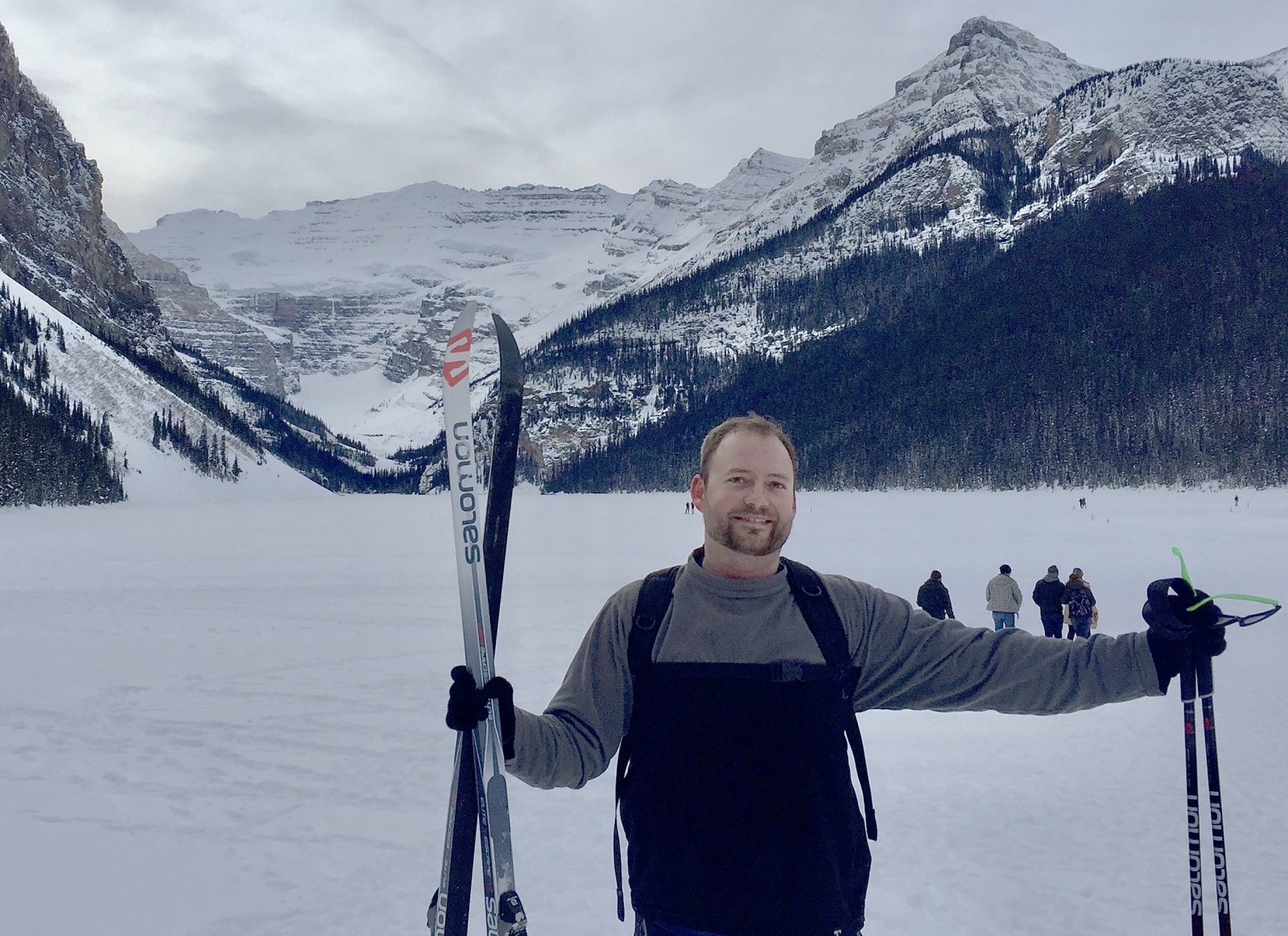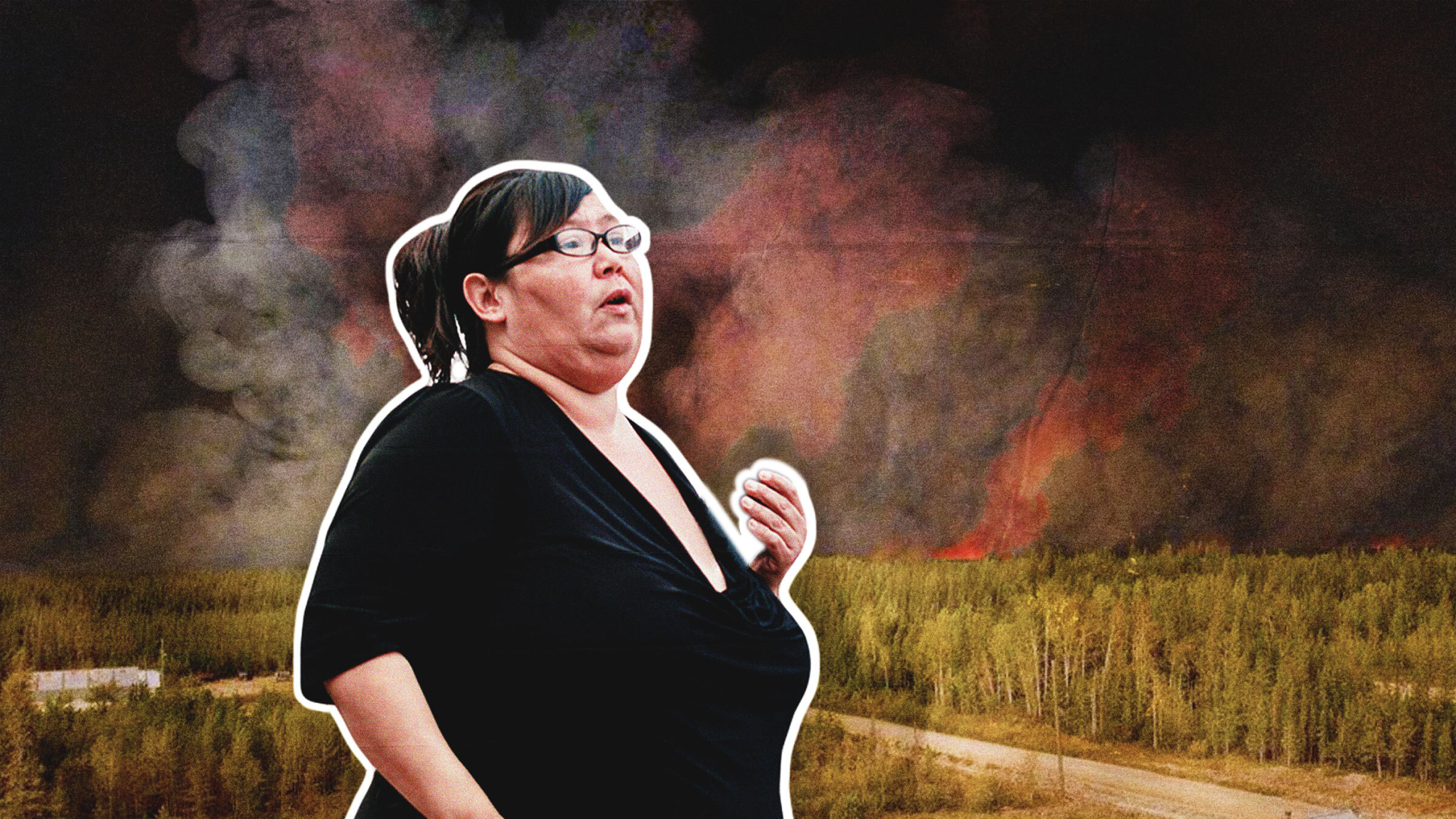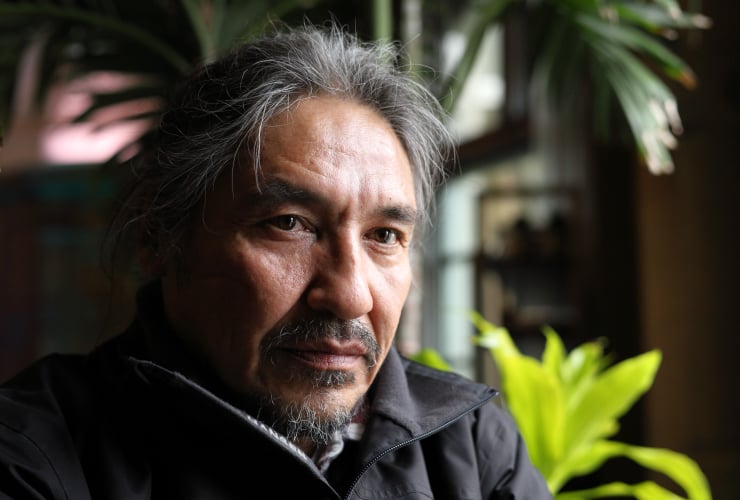The forecast that Sunday called for winds of 50 kilometres per hour. But by afternoon, gusts as high as 90 km/h were propelling a wall of flames toward the hamlet of Enterprise, a mere 45 kilometres south of K'atl'odeeche First Nation.
When April Martel, chief of the nation about 5,000 kilometres south of Yellowknife, left town that Aug. 13 morning, the wind was strong, but it was a beautiful, sunny day.
By the time she drove back in the early afternoon, ashes were raining down on her vehicle.
“Everything was dark and yellow, you know that fiery look to the sky?” she said, recalling the events that led to the second evacuation faced by her community this year.
She immediately called the Northwest Territories’ Environment and Climate Change (ECC) department, concerned a new threat was approaching, Chief Martel told Canada’s National Observer. An earlier fire had forced a month-long evacuation and burned down several buildings on the First Nation.
She asked department staff what was going on, why ashes were falling from the sky and causing her people to panic. They told her, “Nothing is happening right now. The fire is beside Enterprise,” Martel recalled.
Chief Martel called up Kandis Jameson, mayor of Hay River, the town adjacent to the First Nation, and told her the fire was near Enterprise, 38 kilometres south of Hay River. No one had alerted Jameson either. Martel dialled the top ECC representatives.
By 1:30 p.m. that day, they connected over Zoom and told her the fire near Enterprise was out of control. ECC was considering calling an evacuation alert and showed Chief Martel a map pinpointing the fire’s exact location.
“Oh my God,” she said.
Chief Martel wasted no time. She ordered the evacuation alert herself on Facebook and told her people to gather their belongings, gas up and prepare to leave.
Territories officials called an official evacuation at 3 p.m. By 7 p.m., the one highway south to safety closed due to a fire halfway between Enterprise and Hay River, causing officials to point evacuees to the airport, according to CBC. Once the fire tore through Enterprise, the town was almost entirely torched.
Chief Martel isn’t the only First Nations leader who stopped relying on Canada’s national alerting system and turned to alternative methods of communication in the midst of a crisis this summer. Tools such as Facebook, satellite phones and door-knocks are being used by First Nations leaders in the country to keep their communities informed and maintain control over the messaging sent out. After some missed alerts and close calls, experts are recommending governments work with Indigenous communities to develop these tools further.
Mike Westwick, a fire information officer for the Northwest Territories, said it's possible many people did not receive the official alert because the fire interfered with some lines of communication.
In an interview with Canada’s National Observer, Westwick couldn’t speak to the sequencing of Martel’s day, but he noted the fire took down local fibre optic lines, complicating evacuations.
Northwestel, the company whose cables were damaged by the wildfires, said in an email that these telecom disruptions began on Aug. 13, and all communities were reconnected by Aug. 24.
“In all, front-line technicians replaced approximately 20 kilometres of burnt fibre, often working in unforgiving conditions,” Northwestel communications director Andrew Anderson said in an email.
National evacuation alerts are usually sent to cellphones. But in this case, cellular service was down, forcing community members to go door-to-door and use radio broadcasts and other means to reach people, Westwick said. That day, several communities were evacuated, including Hay River and K'atl'odeeche.
“When managing any emergency, including the ones that day, human life has to be the number 1 consideration, and that includes firefighters and aircraft,” he said. “We have to protect people first.”
This year, over four million hectares have burned in the Northwest Territories alone, and for the first time, a firefighter lost their life, Westwick said. Due to human-caused climate change, the frequency and intensity of wildfires will only worsen.
“The most important difference [to other fire seasons] is the human toll that this fire season has wrought,” he said.
A broad-scale review of the fire season will be completed after the season ends and will be publicly released sometime in the new year, Westwick confirmed. A review done after the last major fire season in 2014 was publicly released.
Indigenous-led alerts more accurate, accessible
The disconnect between what Chief Martel’s community was experiencing and what territorial officials were telling her is why some experts say it’s time for First Nations to lead their own emergency response systems.
Emergency response systems created by First Nations can result in more accurate and accessible alert messaging, said Rob McMahon, an associate professor in media and technology studies at the University of Alberta.
Recently, alerts sent during emergency events such as the Upper Tantallon wildfire and West Hants floods in Nova Scotia using Canada's national system have been delayed or missed due to lags in connection between different levels of emergency management, such as front-line responders and municipal officials.
In Chief Martel’s case, similar delays put her community at risk.
“If you're reliant on this centralized system pushing alerts, they may or may not fit what's happening on the ground,” said McMahon, who is also co-founder of the First Mile Connectivity Consortium, a national non-profit association of Indigenous technology groups.
For instance, alerts must be sent out in the correct Indigenous language, using the most widely received method — intricacies a local organization could dedicate more time to getting right, he noted.
“It's about communities deciding what works for their local context.”
In Cape Breton, N.S., the Union of Nova Scotia Mi’kmaq has developed its own alert system featuring a voice-to-text tool for exactly this reason. The Unama’ki Emergency Alert System allows First Nations leaders to dictate alerts in their own language before they are sent via text, email or landline — a feature praised by users of the system.
Based upon his years of experience working with First Nations in Canada, McMahon said statistics on how many First Nations have LTE coverage — the cell service needed to receive Alert Ready alerts — are also unreliable due to occasional outages and expensive repairs.
That’s why governments must support First Nations in Canada to develop their own emergency response systems so leaders like Martel don’t have to resort to platforms like Facebook to reach their communities.
“People in these governments know their citizens best, they know the context best and I think a policy approach that would support and enable community-led solutions works well,” he said.

‘These decisions have to be made by the local community’
About 450 kilometres northwest of K'atl'odeeche First Nation, in Fort Simpson, N.W.T., Grand Chief Herb Norwegian is meeting his community’s needs with a satellite phone safety net.
Wildfires shut down cell service in mid-August in three of the 10 communities Norwegian governs.
The community is heavily reliant on cellphones for communication, so when the fibres burned, communication became extremely difficult for Dehcho First Nations, he said.
Community members near the tiny town of Kakisa missed an evacuation order that had reportedly been issued for the area due to the communications outage.
And when regular systems break down, Chief Norwegian said silence can’t be the default.
“The (fibre) sizzled right up,” he said. “You can't really depend on it too much. You need to look at other systems that are out there.”
That’s why on Aug. 14, in the midst of a communications crisis, he and several other community leaders, including chiefs, RCMP officers and the mayor, gathered in a room in Fort Simpson to discuss emergency management and communications solutions.
Among other actions, they decided to distribute a network of satellite phones — a viable, low-cost, communications solution many neighbouring chiefs and community members already had on hand, Norwegian said.
“If everything else, all the other communication systems went down, at least this one here is still in effect,” he said.
Indigenous and non-Indigenous community leaders in the region are now being equipped with satellite phones, if they don’t already have them.
The satellite phone is more than just a communication tool. For the Dehcho First Nations, it also represents autonomy over emergency response, Norwegian said.
“Do we wait for somebody from the head office, for instance from Yellowknife, to make that decision while an entire community is surrounded by a ring of fire?” he said.
“No, it's ludicrous. These decisions have to be made by the local community.”
This story was produced in partnership with the Climate Disaster Project.
Updates and corrections
| Corrections policyThis article has been updated to confirm that an after-action review of the wildfire season will be made public by the territorial government sometime in the new year.







Comments